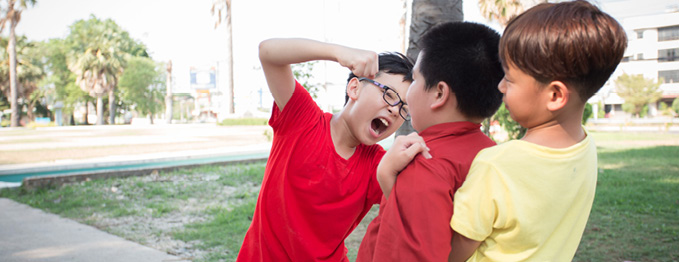In contrast to being a diagnosis in and of itself, aggression is a symptom of complicated underlying causes

Adam may have a typical youth appearance. He attends classes, participates in after-school activities, and hangs out with his peers.
But over the past few months, his family has grown concerned about his actions. He has begun being absent from school and hanging out with the wrong crowd.
He developed the habit of using electronic cigarettes and began to spend most of his time playing online video games with a particular gang of teenage dropout lads. His mother said that some money went missing more recently, and he was found to have lied to his parents.
He started using foul language with family members and disregards any counsel. Their concern increased when his family learned that Adam was engaged in bullying.
His family’s worries escalated when they were recently informed that Adam was involved in bullying at school, where physical fights have led to serious physical injury to the victims. Adam is at risk of being expelled from school and, worse, could be prosecuted.
Sad, furious and puzzling at the same time – this is a common reaction we get every time we encounter news regarding violent behaviour among children and adolescents, just like what happened to Adam. Bully, gang rape, physical aggression and many other unwanted behaviours still tragically occur within schools, homes and community involving minors.
Although children are not commonly associated with this kind of act, the presence of these issues nevertheless should not be ignored. According to the Department of Statistics Malaysia (DOSM), the number of children involved in crime in 2020 increased by 10.5 per cent to 5,342 cases compared to the previous year (4,833 cases).
First offence increased by 15.7 per cent to 4,916 cases while repeated offences recorded a decrease of 27.2 per cent to 426 cases compared to the previous year. According to the Malaysia Crime Prevention Foundation, various forms of bullying affect 84 per cent of children under 18. The bullying took many types including cyberbullying and, in some cases, physical violence which led to severe injuries and even death.
It can be difficult and challenging to assess children’s hostility and violence. In contrast to being a diagnosis in and of itself, aggression is a symptom of complicated underlying causes.
 In some circumstances, such as a child’s response to threats in their daily lives, aggression can be adaptive. However, the problem must be handled holistically when aggression develops into a maladaptive and persistent behaviour that puts the kid and others in danger.
In some circumstances, such as a child’s response to threats in their daily lives, aggression can be adaptive. However, the problem must be handled holistically when aggression develops into a maladaptive and persistent behaviour that puts the kid and others in danger.
This includes a professional evaluation to ensure there are no undiagnosed psychiatric issues that might have influenced the issue. For instance, a study conducted in 2002 by Teplin and colleagues found that up to 70 per cent of young offenders have at least one psychiatric diagnosis.
Risk factors for aggression among children and adolescents
It is hard to narrow down the cause of aggression in children into a single reason. In many circumstances, the problem occurs as a result of interaction of multiple factors. To clarify our perspectives into this matter, Hilt and French (2011) divided the causes into three main components.
♦ Individual risk factors
- Genetic susceptibility
- Prenatal toxin exposure
- Difficult temperament as a child
- Cognitive deficits
- Affect dysregulation
♦ Family risk factors
- Maltreatment and neglect
- Inadequate parenting
- Family dysfunction
- Marital conflict
♦ Community risk factors
- Peer rejection
- Antisocial peer group affiliation
- Neighbourhood violence
- Media violence exposure
Diagnostic consideration
Clinicians must consider the surrounding circumstances when determining the clinical cause of violent behaviour. We must first comprehend the nature of aggression, the progression of such conduct, typical triggers, and the effects of such behaviour, including the responses of family members and educators.
Additionally, we must carefully assess other factors like developmental disorders, cognitive challenges, psychosocial stressors, and additional co-occurring psychiatric illnesses like mood, anxiety, and psychosis. Investigating the child’s use of drugs and other illegal activity and any indications of probable medical sickness is crucial. As many pertinent people as possible should be involved in the assessment, which should be conducted in several contexts.
The assessment should be done in a calm, safe, non-judgemental and supportive nature. In any setting where the child is still actively displaying aggressive behaviour, one must ensure the child’s safety and all individuals involved in the assessment.
Calmly approach the child, use clear communication and set firm boundaries. Assess the needs of the child and tackle the needs accordingly.
In situations where there are signs of family conflicts, we need to ensure that we assume a neutral stance and try to understand the situation from all angles. It is also detrimental to assess the modelling of aggression in the family and the history of victimisation in the child’s life.
In situations where the problems escalate, ensure the child is being managed by the specialised team with experience in dealing with such situations. Involvement of the child and adolescent psychiatry team and the welfare department is important to address the issue safely.
There are three childhood disorders commonly grouped together as potentially contributing to the disruptive behaviours – conduct disorders, oppositional defiant disorder (ODD) and attention deficit and hyperactivity disorder (ADHD). In some situations, the diagnosis may involve more than a single diagnosis entity.
For example, a child with ADHD may display ODD-related behaviour due to being bullied and consequently develop depression and social anxiety. Hence the diagnosis of merely ADHD or ODD may not have tackled the entirety of the problem.
The management will depend on the situational context of the problem, any primary psychiatry diagnosis and ensuring proper social and educational support. Seeing the problem from a medical perspective is more important rather than simply looking at it from a legal perspective.
The underlying issues need to be addressed from the root of the problem. More importantly, all parties must be ready to take part in preventing cases like Adam’s from happening. Parents, school, community, and health professionals need to play their roles seriously to ensure that all potential risk factors can be curbed, and any further damage avoided. – The Health








